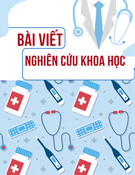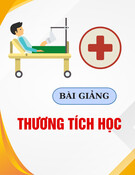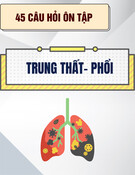
Can Tho Journal of Medicine and Pharmacy 9(5) (2023)
120
6. Rajesh, M., Nagaraju, K., & Buhary, SSM (2012), Formulation and evaluation of
clarithromycin immediate release film-coated tablets, Cellulose, 4(5), pp. 352-357.
7. Elliott, William J., and C. Venkata S. Ram. (2011), Calcium channel blockers, The Journal of
Clinical Hypertension, 13(9), pp. 687-689.
8. World Health Organization (2021), Guideline for the pharmacological treatment of
hypertension in adults: web annex A: summary of the evidence, World Health Organization.
9. Zaid, AN, et al. (2014), Formulation and bioequivalence of two Valsartan/Amlodipine
immediate release tablets after a single oral administration, Pakistan Journal of
Pharmaceutical Sciences, 27(4), pp. 755-762.
(Received: 10/10/2022 – Accepted: 14/02/2023)
KNOWLEDGE, ATTITUDE, AND PRACTICE OF HAND HYGIENE
AMONG NURSING STUDENTS AT CAN THO UNIVERSITY OF
MEDICINE AND PHARMACY
Nguyen Thi Ngoc Han*, Hoang Thi Thuy An, Mai Thuy Khanh Doan, Phan Thi Dung,
Ho Thi Hong Dao, Nguyen Thai Thong, Lu Tri Dien, Duong Thi Thuy Trang
Can Tho University of Medicine and Pharmacy
Corresponding author*: ntnhan@ctump.edu.vn
ABSTRACT
Background: Healthcare-associated infections are major causes of morbidity and mortality
associated with clinical, diagnostic, and therapeutic procedures in healthcare organizations.
Enhancement of hand hygiene practices among healthcare workers is responsible for decreasing 30
to 50% of healthcare-associated infections. However, previous studies have indicated inadequate
adherence to hand hygiene procedures in healthcare institutions. Therefore, increasing knowledge,
attitude, and practices of hand hygiene among nursing students who participate in caring for
patients is essential to improve the quality of care and patient safety. Objectives: This study aimed
to examine knowledge, attitude, the practice of hand hygiene, and their associations among nursing
students at Can Tho University of Medicine and Pharmacy. Materials and methods: A descriptive
correlational study was conducted with 104 nursing students as study participants. Knowledge and
attitude were examined by using a self-structured questionnaire, while practice was evaluated by
observation based on the hand hygiene checklist of the Vietnamese Ministry of Health. Results: The
findings showed that 44.2% and 66.3% of participants had good knowledge and positive hand
hygiene attitudes, respectively. Poor adherence of 5 moments of hand hygiene and 6 steps of the
hand hygiene procedure were revealed. Half of the respondents showed low to moderate compliance
with the hand hygiene procedure. There were significant associations between knowledge, attitude,
and hand hygiene practices among nursing students. Conclusion: among nursing students, poor
knowledge, attitude, and hand hygiene practices were reported. The study findings supported
previous literature and found that respondents emphasized the importance of training programs and
hand hygiene monitoring in improving hand hygiene practices.
Keywords: hand hygiene, knowledge, attitude, practice, nursing students.






























